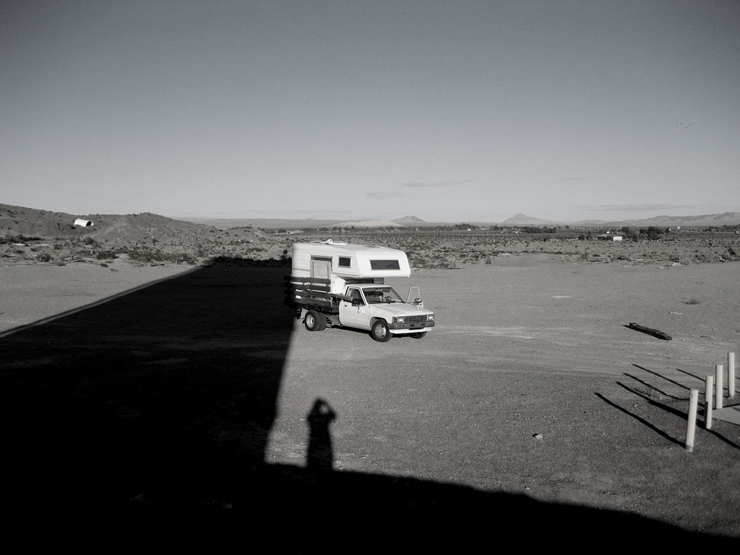FOUR art show featuring works by Dave TREE, Adam O’Day, Elizabeth Kirby Sullivan and Mike Hammecker
Lot F Gallery 145 Pearl St #4 Boston Ma
Friday Nov 2 7-11pm
FOUR art show featuring works by Dave TREE, Adam O’Day, Elizabeth Kirby Sullivan and Mike Hammecker
Lot F Gallery 145 Pearl St #4 Boston Ma
Friday Nov 2 7-11pm
The twins have left Boston, but not before they opened their first solo museum show in the U.S. and left behind a handful of public installations that have garnered major attention as people once again grapple with the concept of art in the streets. Otavio and Gustavo Pandolfo have done large installations in large cities before, but few as visible and central to a city as their 70 x 70 foot mural on the side of a “Big Dig” ventilation building rising above the greenway with the shape of the character’s formed by the semi-circular façade.
Photographer and BSA contributor Geoff Hargadon says that the project received permission from a number of civic and private organizations before it could go up over ten days in July in this storied city that usually favors conservative historical themes in it’s public works. “Given the short amount of time organizers had to put the pieces together and get all the approvals,” says Hargadon while ticking off names of entities who green-lighted the project, “it was a small miracle it was able to get off the ground.”
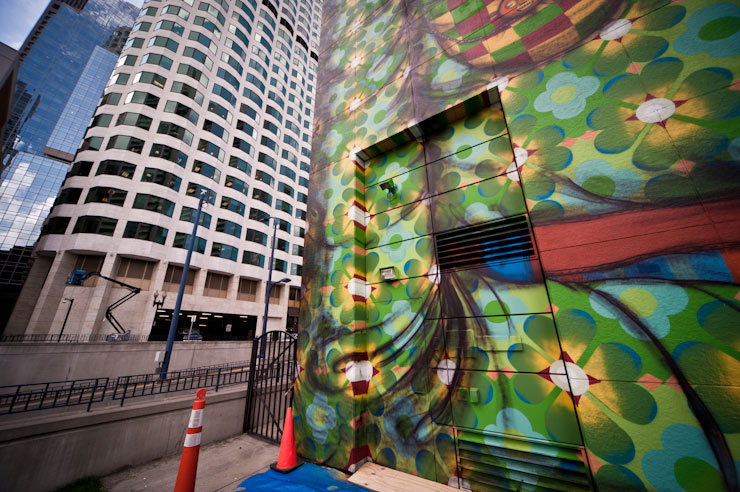
The internationally known Brazillian Street Artists had time to create a few pieces around town that reference their more graffiti-influenced roots, including one each on the side of a hotel, a pizza place, and a van. Not surprisingly it was the seven storey portrait of a seated barefoot boy rendered in signature Os Gêmeos yellow and wearing shrouded headgear that got the most attention on the Rose Kennedy Greenway at Dewey Square. Its bright colors and patterned pajama-like garb have a cheerful childlike appeal to some picnickers, while other townies and Internet commenters see something less attractive, even sinister, depicted here where much of the Occupy Boston protests took place in the last year.
By the time “The Giant of Boston” had been discovered by equally yellow media types, the barefoot boy had been transformed into a danger in this birthplace of democracy and a small media-generated dust bowl was kicked up. “Looks like one of the Simpsons dressed like a terrorist,” said a clever commenter on a local TV affiliate’s Facebook page, one of over 200 who offered their considered opinions on the mural’s appearance.
As with most knee-jerk assessments, this one could be tempered with a few minutes of Googling the work of the artists, which would reveal that this figure fits quite neatly into the dreamscape tableaux of oddly costumed and funnily proportioned figures whom the Twins have been painting for a few decades. But who knows, each of those little kooky figures could have been bombers and no one realized it until now. Without adding credibility to that line of unthinking, Hargadon remarks about these aerosol bomber brothers, “Maybe Os Gêmeos have inadvertently done us all a favor by helping us understand how some people have come to see the world during the past ten years. In any case, like all noteworthy art, it is not meant to please everybody.” If that’s the case, “The Giant of Boston” is noteworthy.
Of more important note is the solo show by Os Gêmeos that has opened concurrently at The Institute of Contemporary Art Boston. Organized by Pedro Alonzo, who also curated the Swoon, Shepard Fairey, and Dr. Lakra shows for the ICA, it’s a somewhat intimate overview of their professional and personal journey as artists, peppered with a few surprises from inside the imagination of these in-the-moment creators who “depict their visions in surreal paintings, sculpture, and installations,” according to the shows official description. Reporting on the makeup of the pieces exhibited, Hargadon says, “Some of them are from the recent show at Prism LA, while others are older works. The VIP opening on Tuesday was packed, and was followed by a Brazilian themed party Friday night – which was sold out.”
If you get to Boston to see this show and this large mural, make time in your trip to see the brothers other works in less obvious locations to get a greater appreciation for their history growing up as teens in the mid 80s while pouring over books like “Subway Art” and seeing the hip-hop and graffiti scene from New York spreading around the globe. You’ll find a mural at the Revere Hotel on Stuart Street and a piece they did along with a handful of friends in Union Square in Somerville at Mama Gina’s Pizza. Among the other contributors to that piece were RIZE, Coyo, and Caleb Neelon.
<<>><<>>BSA<<>><<>>BSA<<>><<>>
The exhibit at the ICA will be up through Thanksgiving, 2012. Click here for further information regarding this exhibition.
<<>><<>>BSA<<>><<>>BSA<<>><<>>
“The Giant of Boston” mural at the Rose Kennedy Greenway at Dewey Square will be up for 18 months.
<<>><<>>BSA<<>><<>>BSA<<>><<>>
Our special thanks to BSA contributor and photographer Geoff Hargadon for capturing these amazing images of the walls going up and for the coverage of the installations inside the museum.
See our interview in August 2010: Futura Talks: Completion of the “Kid” at PS11 with Os Gemeos
<<>>><><<>BSA<<>>><<<>><><BSA<<>>><><<>BSA<<>>><<<>><><BSA
Please note: All content including images and text are © BrooklynStreetArt.com, unless otherwise noted. We like sharing BSA content for non-commercial purposes as long as you credit the photographer(s) and BSA, include a link to the original article URL and do not remove the photographer’s name from the .jpg file. Otherwise, please refrain from re-posting. Thanks!
<<>>><><<>BSA<<>>><<<>><><BSA<<>>><><<>BSA<<>>><<<>><><BSA
August 1–November 25, 2012
The ICA presents the first solo U.S. exhibition of Brazilian artists Os Gemeos. The ICA exhibition will include a selection of the artists’ paintings and sculptures, as well as a public mural outside the museum
Organized by Pedro Alonzo, ICA Adjunct Curator
This August the ICA will present the first solo exhibition in the United States of works by the Brazilian brothers Otavio and Gustavo Pandolfo. Best known as Os Gêmeos, the twins are a major force in graffiti and urban art. The twins have a deep bond; they are tireless collaborators and say that they often experience the same dreams. In an effort to share their dreams with the world, they depict their visions in surreal paintings, sculpture, and installations: human figures with removable faces, exploding bursts of color, and room-size heads installed with shanty interiors.
Os Gêmeos draw not only from dreams, but also from their surroundings, incorporating these elements to forge a unique visual style. Their narrative work is a visual synthesis of their everyday lives: the color and chaos of Brazil—particularly in their neighborhood in São Paulo, Cambuci—or yellow-skinned youth in red hoodies breaking into train yards and painting in subway tunnels. A common motif depicts several graffiti taggers garbed in brightly patterned clothes stacked atop one another to reach an impossibly high spot. In contrast to the more contemporary urban themes, rural Brazil has an equally significant presence in their work. Carnivals, music, and folk art fascinate the twins and inspire fantastical portraits of musicians and paintings of processions and festivals—all of which are based on their own photographs.
Os Gêmeos date their artistic beginnings to 1987 when hip-hop invaded Brazil. The music and images of youth dancing and painting graffiti, transmitted via photo books and films, left an indelible mark on the twins. But in the late 1980s, the lack of information about art and art-making materials—Brazilian spray paint was expensive and inferior in quality—forced the artists to improvise and create their own visual style. They began painting New York graffiti–style murals with house paint, brushes, and rollers instead of spray paint. In 1993 while in Brazil, Os Gêmeos met then emerging artist Barry McGee. He provided magazines, materials, and information and began to paint with the twins. McGee was making a living as an artist, a fact that inspired the twins to quit their banking jobs and focus entirely on working as artists. Today they are two of the most prominent figures in public art, having succeeded in creating large-scale murals and painting public transportation throughout Brazil.
To Os Gêmeos labels—as well as reality—are not important. They do not consider themselves street artists, they “just want to paint.” Their art in public spaces, which they refer to simply as graffiti, is a means to share their work with a broad audience. This exhibition will highlight the multiple influences and recurring visual themes found in the artists’ paintings and sculptures, and allow audiences an opportunity to experience their richly fantastical work. As part of the exhibition, the artists will visit Boston in August 2012 to paint a large-scale, site-specific mural.
The Institute of Contemporary Art
100 Northern Avenue
Boston, MA 02210 General Information
617-478-3100
info@icaboston.org
Darkclouds Solo Exhibition “Same Old, Same Old” @ Lot F Gallery, Boston. Friday Night!!
Hello Friends and enemies alike!
If you find yourself near Boston, MA on Friday Night please come through Lot F Gallery for “Same Old, Same Old” my solo showing of the darkclouds! Located downtown in the bean, it’s an amazing space and I’m quite psyched… Drinks, tunes and tons of drippy art!
Would love to see you there!
Info about the show:
Opening Reception: Friday, June 1st, 7-11pm
Lot F Gallery, 145 Pearl Street, Boston MA.
Street Wall is an exhibition dedicated to artists who work on city walls to create public art. The artists highlighted in the exhibition are creating an installation directly on the gallery walls. Each artist is given a 2 to 4 panel section of wall space on the interior of the gallery for them to wheat paste work in the gallery resulting in pristine versions of their public work as well as initiating a collaboration in close quarters. Curated by William Stitt at Fourth Wall Project in Boston. The show runs from Feb. 4 – Feb. 23
LNY, Radical!, Tiptoe, Nanook, The Phantom, Geoff Hargadon, Zatara and Blackmath. LA artist, The Phantom, has been working as a street artist internationally for over twenty years. He has directed videos for Rage Against the Machine and has also done their cover album art for “The Battle of LA.” Local Boston based artists Zatara and Blackmath have been working primarily in the area but have travelled all over to bring their unique work to the streets. Zatara uses collected screen printed images that combines visually overstimulating scenarios of apocalyptic visions of society. Blackmath employs large woodcut prints in his wheat paste work. Intricate and beautiful it plays on emotions that are both whimsical and dark. Geoff Hargadon’s “Cash For Your Warhols” signs can be seen all over cities internationally. His collection of signs are part social experiment, making the viewer question its reality in our capitalist heavy landscape. New Jersey artist LNY’s work is both visually stimulating and carries an energy of offbeat images. New York based artists Tiptoe and Radical! have been populating the streets with their images. Tiptoe uses mythological imagery in his savage and beautiful images that cause the commonplace walls in which they are pasted to become something more ethereal. Radical! Works both on the streets and off employing scenes of darkly comedic characters. Nanook, from Baltimore, uses humans and animals in his animated line work wheat pastes. The style of his works moves perfectly on the walls of abandoned Baltimore buildings as well as in the gallery. Live screen printing by Antidesigns.
Founded in 2009, by the Bodega Crew with a goal of creating more places for punks to loiter, artists to flourish, and more voices to be heard.
The idea was to turn dormant commercial spaces into pop up gallery spaces reclaiming urban space for public art projects and progressive exhibitions. We keep it independent/free form and curate cultural artifacts for the neighborhood. We settled into our current location at 132 Brookline Ave. Boston MA 02215 a wonderful 3,000 square foot gallery with many possibilities.
Saturday, December 10, 3-5pm
we will have all sorts of CFYW stickers – and EVERYBODY likes stickers, right?!
Her name is unpronounceable, so people just call her Mrs. Bennett. One of the last aboriginal people in Australia, she sits atop a rolling line of four-eyed Tibetan demons with human faces who are sucking species into their mouths on this wall installation at the Institute of Contemporary Art/Boston (ICA). Traditionally these demons would be protective, but “Swoon really sees these as a representation of humanity’s need to devour, and in excess, to destroy“ explains Pedro Alonzo, curator of the show, as he gives guests a tour of “Anthropocene”, the two part installation by the Brooklyn Street Artist. The shows’ name refers to the current era, and according to Wikipedia, “The Anthropocene is a recent and informal geologic chronological term that serves to mark the evidence and extent of human activities that have had a significant global impact on the Earth’s ecosystems.”
Part two of the installation at this modern museum overlooking the Boston waterfront is the mini temple suspended from the ceiling in the entry hall to the galleries, best viewed from the glass central elevator that carries you from floor to floor. With joints hand-tied in a manner Swoon learned from Chinese scaffolding architecture, the 400 pound structure is made of bamboo, copper, and multiples of hand cut paper animals, species endangered or soon to be in this era of human destruction on Earth. “She built the structure in four parts, we assembled it and installed it (over 6 days), and she draped it with these materials, ” said Alonzo.
During the installation the main hall was reserved for work tables and a temporary print shop, where many assistants spent hours hand cutting the animals and shapes that adorn the works and the parade that swings from the ceiling connecting the two areas. Seahorses, frogs, beetles, and butterfies all create the chain of life in this intuitive biologic story of connective species and collective endangerment. Disappearing before they can become fossils, the animal world is memorialized in this most ephemeral of materials, an exhibition that will similarly be destroyed when the wall is sanded and painted. In this impermanent way, it best mimics the installations Swoon does on the street.
Then out to the streets of Boston we went, hitting a number of spots with the guidance of photographer, artist, and Street Art expert Geoff Hargadon, who began one of the city’s only organic walls for Street Art and graffiti art in 2007. A natural magnet for painters and wheat-pasters, the ever-changing dialogue of “The Wall” on display is periodically wiped clean for a new group installation. The outdoor gallery has provided an outlet for hundreds of local and visiting artists as well as a providing a backdrop to photo shoots, video, and television programs. On the day we were there, a dancer was set to perform her moves under bright lights in the alleyway. Below are images from that days tour.
With special thanks to Swoon, Pedro Alonzo, the ICA, and sincere gratitude to Geoff Hargadon.
It’s been a few weeks since BSA first showed images of the protesting marchers of Occupy Wall Street and the number of everyday people from many walks of life in the streets has only bolstered what the kids have been saying. Now it looks like the marches have spread to hundreds of other cities in the country and around the world. All this in less than a month? It’s like it was waiting to happen.
In the intervening days the rapidly blossoming movement has been endorsed and reviled by many a political figure and well-known media personality. While some shiny happy telecasters seem bewildered by the discontent – the majority of people you talk to on the street or whom you stand behind at the grocery store or bank aren’t particularly mystified by the marchers or their myriad messages. It’s the same stuff people have been talking about at their kitchen table for years now – and now they’re talking together in the public square. Oops.
Aside from the populist uprising aspect of it all, the art in the street during these Occupy marches has been pretty good. So have been the slogans, the witty turns of phrase, the clever costumes and dramatic street theater. Is there any question that Street Art will be reflecting what is happening in the streets? In many ways, it already has been – our recent talks at LA MOCA and the New York State Museum concentrated on the tea leaves of the street telling us for the last few years about homelessness, the effects of war, the struggles of the working class, and the housing crises. For many Street Artists this stuff is personal and they’ve been telling their stories with their art.
Here are some of the scenes we caught of the Occupy Boston and Occupy Wall Street marches recently; it will be very interesting to see how art and popular culture are influenced by what is now on display in the Streets. When you call yourself the 99%, you’ve cast a pretty wide net.
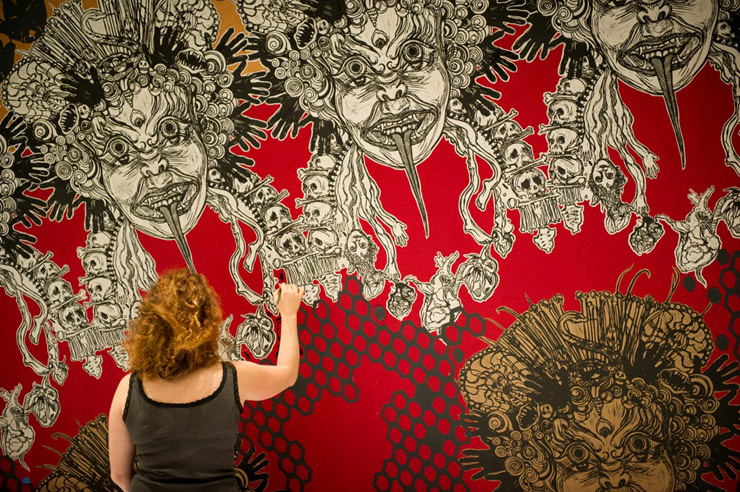 Swoon at work installing “Anthropocene Extinction” (photo © Geoff Hargadon)
Swoon at work installing “Anthropocene Extinction” (photo © Geoff Hargadon)There’s a good chance you’ve encountered Swoon’s work before: her intricately cut, life-sized portraits have covered abandoned buildings and warehouses in cities around the world. Often found in beautiful states of decay, her wheat-pasted installations are populated by realistically rendered people going about everyday activities in a cityscape of her own invention.
In both her art and her own life, Swoon is deeply engaged with social and humanitarian projects. During the 2009 Venice Biennale, she and a crew of 30 other artists and friends sailed SWOON boats made of reclaimed materials through the canals of Venice—creating new purpose out of what was cast aside. Her latest endeavor, the Konbit Shelter Project, is a sustainable building project assisting Haitians who lost their homes in the devastating 2010 earthquake. Working alone or in collaboration, Swoon’s work is often about forming a community in order to practice what she refers to as a “real world” engagement.
For the ICA’s fifth installation of the Sandra and Gerald Fineberg Art Wall, Swoon’s installation will extend from the elevator atrium to the lobby, soaring 40 feet up to the ceiling—the largest installation to occupy the Fineberg Art Wall. The work, titled Anthropocene Extinction, is composed of streams of intricately cut paper which connect key sculptural elements within the installation, including a 400-pound, suspended bamboo sculpture. The exhibition is accompanied by an ICA-produced video featuring installation footage and an interview with the artist.
To find out more about this exhibit, location, time, dates and directions visit ICA site at:
http://www.icaboston.org/exhibitions/upcoming-exhibitions/swoon/
 Swoon (photo © Geoff Hargadon)
Swoon (photo © Geoff Hargadon)Opening tonight at the Institute of Contemporary Art in Boston, is an exhibition of new work by Brooklyn Street Artist SWOON, called Anthropocene Extinction.
“The title addresses humanity’s impact on the environment,” says Pedro Alonzo, the Adjunct Curator of the show and the guy who brought the very successful Street Art exhibition “Viva La Revolucion” to San Diego last year.
Kind hearted and focused powerhouse SWOON continues her efforts to engage viewers at ICA with her hand cut wheat pasted installations of real people and mythical ones, symbolically telling a tale that brings responsibility for the environment directly to our feet. Wholistic in many respects, we find familiar recurring themes in the subject matter, the construction techniques, even the manner of fruition of the installations; The localized environment in which Swoon’s work evolves mirrors the collaborative vision and processes that will be necessary to address the very real issue of sustainability and disaster more populations are facing.
For the politically charged time we’re in, a show like this could open itself to charges of smug liberal self satisfaction if the artists’ body of work and projects to create shelter from the storm were not so consistent and authentic. A person entirely engaged in every process, Swoon facilitates others’ stories and incorporates them along with more material considerations, like the 400-pound bamboo temple structure hanging from the ceiling here that uses traditional Chinese construction methods the artist has been studying (It’s excellent when viewed while riding the elevator). Balancing the durability of reinforced joints with the fragility of cut paper species floating through air, the exhibit calls to mind the range of responses we will need to employ if the march toward planetary destruction is to reverse, and if SWOON’s characters are going to survive.
Our thanks to photographer and BSA contributor Geoff Hargadon, who has been documenting Swoon’s installation for the show and who shares images with you here.Support for the Swoon installation is provided by Fotene Demoulas and Tom Coté, Geoff Hargadon and Patricia La Valley, Tim Phillips, and Connie Coburn and James Houghton.
Learn more about the exhibition Anthropocene Extinction at the ICA website HERE:
Read BSA’s interview with Pedro Alonzo here about his curatorial experiences on Viva La Revolución at the Museum of Contemporary Art San Diego last year.
Listen to an interview with Swoon and Pedro Alonzo on Boston’s WBUR.
Using sparklers and an open shutter, artist Gary Stubelick creates glowing panegyrics to light up the urban night. The Boston based creative director has been exploring the fine art of time and light for a few decades and creates incandescent odes to hot summer nights in the city with his interpretation of mundane features of the urban landscape.
A time lapse photographer since 1973, the artist “paints” objects discarded, overlooked and discovered with sparklers, incandescent tungsten, and highway flares, giving them shooting star status, if just temporarily. This public art art is less than ephemeral – it only existed briefly and linearly, with it’s layers collected here and displayed as one perfect moment.
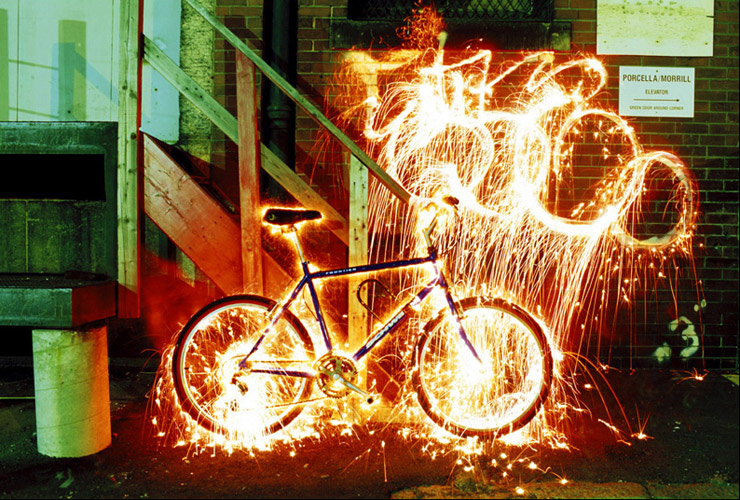 Blowing up a tag and this messengers’ bike while he’s inside delivering a pizza. “Urban Frontier” (photo © Gary Stubelick)
Blowing up a tag and this messengers’ bike while he’s inside delivering a pizza. “Urban Frontier” (photo © Gary Stubelick)“The idea behind the shot was to combine the renegade nature of graffiti with the explosive energy of pyro. I utilized ballistic sparklers to achieve the splattered paint effect. The bike is a Schwinn Frontier mountain bike which accounts for the title, ” says Stubelick.
To see more of Mr. Stubelick’s work click on the link below:
The fine artist and Street Artist named Purth has been completing an urban installation of her family this winter in Austin, Boston, Brooklyn, Cincinnati, and New Orleans . Not literally her blood relatives, the oversize portraits of females are mirrors of her emotional journey and echoes of relationships she may have experienced coupled with ones she is creating for her future. Coupled with bits of prose that ground them somewhat, these women are strong and searching.
This kind of internal migration is not unusual for a painter in scanning the horizon for something however the actual physical distance run, with it’s long spaces of time and travel in between, is. It’s also something that Street Artists around the globe are setting a new standard for by completing installations in towns and cities around the globe much like a campaign. In her dog-eared travelogue, Purth carries ruddy hued people from her fluid imagination and raises them amidst abandoned rubble; high enough to be seen from a distance.
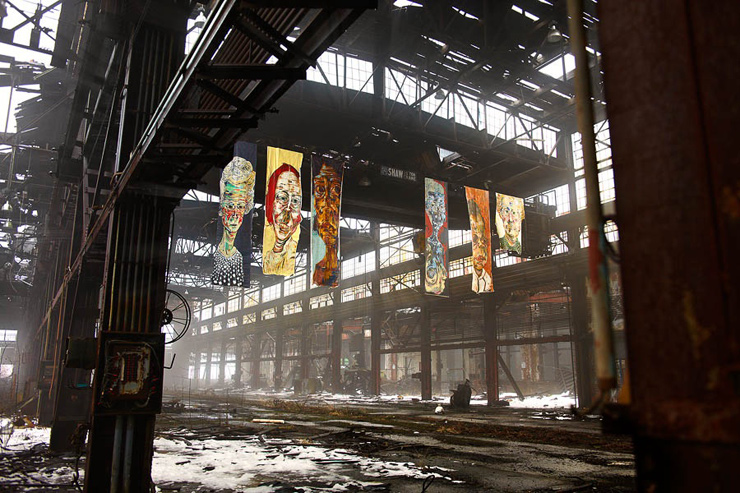 Purth “The Deleras” group in an abandoned train yard east of Boston. (Photo © Heather McGrath)
Purth “The Deleras” group in an abandoned train yard east of Boston. (Photo © Heather McGrath)Having completed roughly the first half of the installations for “The Deleras Project”, she shares these images before Purth hits the road again to complete it with installations in Oakland, Los Angeles, Minneapolis, Chicago, Detroit and Cincinnati.
With the completion of “six months on the road, (with) snow storm & tornadoes endured, a car accident survived, and life affirming environments broken into,” the artist took a moment to chat with Brooklyn Street Art about her project:
Brooklyn Street Art: Who are the individuals depicted on your paintings?
Purth: Each piece was created from different sources of inspiration: references of old photographs I’ve been collecting for years, reflections … perhaps of someone’s lover, someone’s child. There will be ten once the work is completed, all of women, young & old, scattered across the country, & each installed with a single stream of thought. The writing is sourced in a very similar way … some pulled from found material, some from the words I was lucky enough to hear uttered; fragments to create a whole. I guess in my mind, they have become the women they are now. Completely independent of the remnants that built them up or who they are to me personally. I hope that for them … the right to stand on their own.
Brooklyn Street Art: Why are you traveling around the country putting them up on abandoned walls and buildings?
Purth: Abandoned spaces have a pronounced hum to them. They are shed, in a sense, but are still heavy with profound undercurrents that I believe can be tapped into … & reinvented. It seems completely fitting for me to search out these spaces as possible locations for the work even if they ultimately make home above, along side, or in areas close by. In regards to the distance covered … we have gaps that need to be bridged. I see them as shepherds and black sheep. It’s my responsibility to find them home.
Brooklyn Street Art: What is the genesis of this project?
Purth: The first, Delera, was created at an intense, pivotal moment in my life. I became very weak around the end of 2009 and I began painting her like a child screaming at an overbearing parent. In the simplest sense, I was depicting the strength I needed to rediscover in myself. Once she was suspended and I saw her upright for the first time, she literally took my breath away. Something so intimate, so tender, and so sincere towering over me … it was like gold leafing vulnerability and then lighting the shit on fire.
She was the first, the idea for the others quickly followed.
